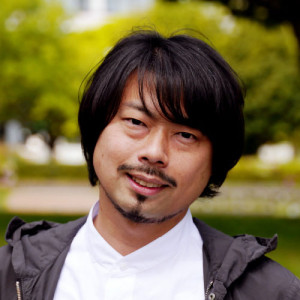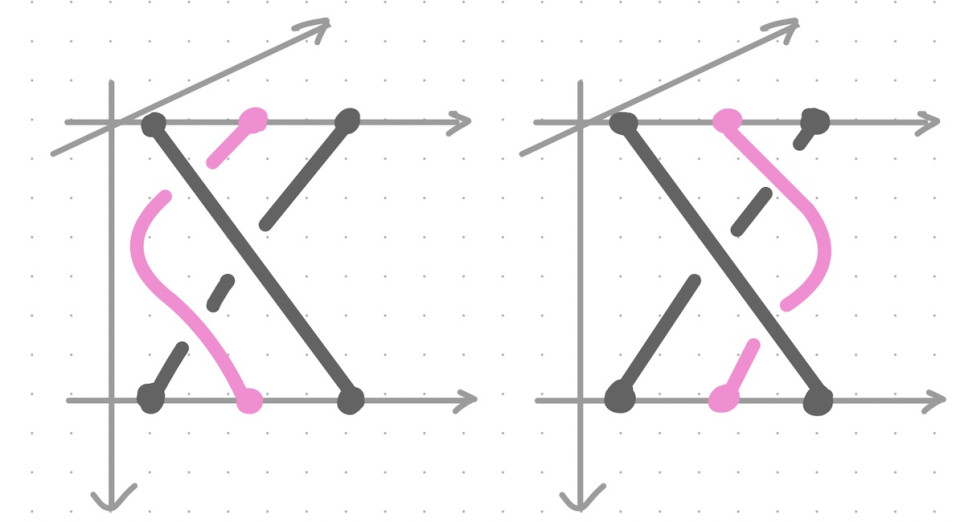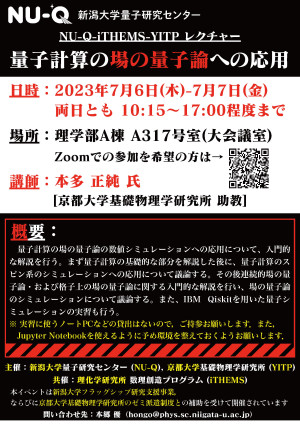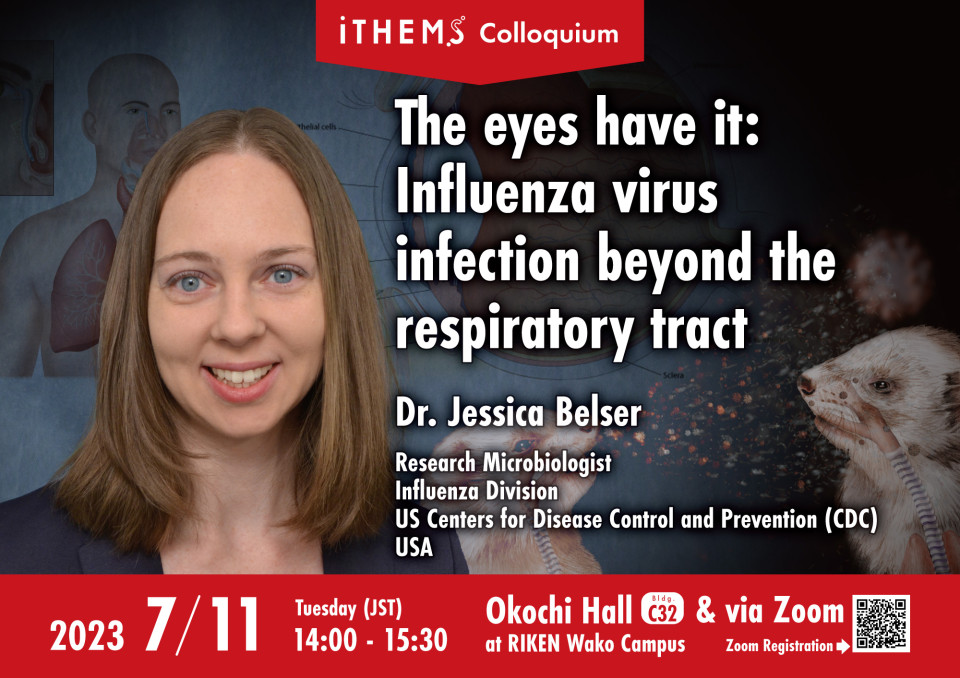Volume 257
Back to Newsletter List
Upcoming Events
Workshop
Supported by iTHEMS
6th Workshop on Virus Dynamics
July 4 (Tue) - 6 (Thu) 2023
Catherine Beauchemin (Deputy Program Director, RIKEN Interdisciplinary Theoretical and Mathematical Sciences Program (iTHEMS))
Shingo Iwami (Professor, Graduate School of Science, Nagoya University)
The Workshop on Virus Dynamics is an international meeting held every 2 years. It brings virologists, immunologists, and microbiologists together with mathematical and computational modellers, bioinformaticians, bioengineers, virophysicists, and systems biologists to discuss current approaches and challenges in modelling and analyzing different aspects of virus and immune system dynamics, and associated vaccines and therapeutics. This 6th version of the workshop builds on the success of previous ones held in Frankfurt (2013), Toronto (2015), Heidelberg (2017), Paris (2019) and virtually (2021). It is supported by the Interdisciplinary Theoretical and Mathematical Sciences (iTHEMS) program at RIKEN, by Nagoya University, and by the Japan Science and Technology Agency. Up-to-date information and registration is available via the website. The workshop is for in-person participation only (no virtual or hybrid option).
Venue: Noyori Conference Hall, Higashiyama Campus, Nagoya University
Event Official Language: English
Seminar
iTHEMS Math Seminar
Introduction to braid groups
July 5 (Wed) 14:00 - 16:30, 2023
Haru Negami (Ph.D. Student, Graduate School of Science and Engineering, Chiba University)
Part 1 (14:00-15:00): Introduction to braid groups
Braid groups are groups that are defined by figures formed by the entanglement of n strings. Besides this geometric realization, it is a very interesting field where algebra and analysis intersect. In the first half of this seminar, aimed mainly at those unfamiliar with braid groups, we will introduce three aspects of braid groups and review the history of the research. In particular, in the area of its relation to analysis, the relationship between KZ equations and braid groups will be introduced.
Part 2 (15:30-16:30): Representations of braid groups and the relationship between monodromy representations of KZ equations
In the second half of the talk, after a brief introduction to representation theory, we will introduce the Katz-Long-Moody construction, a method of constructing infinite series of representations of the semi-direct product of braid group and free group. We will also show that its special case is isomorphic to multiplicative middle convolution, a method for constructing monodromy representations of KZ equations. Lastly, we will also discuss the connection between representations of braid groups and knot invariants. The talk includes joint work with Kazuki Hiroe.
Venue: Seminar Room #359, 3F Main Research Building, RIKEN / via Zoom
Event Official Language: English
Lecture
Co-hosted by iTHEMS
NU-Q-iTHEMS-YITP Lecture: Applications of Quantum Computation in Quantum Field Theory
July 6 (Thu) - 7 (Fri) 2023
Masazumi Honda (Assistant Professor, Yukawa Institute for Theoretical Physics, Kyoto University)
This lecture aims to provide an introductory explanation of the application of quantum computation in numerical simulations of quantum field theory. We will begin by covering the fundamental aspects of quantum computation, followed by a discussion on its application to simulating spin systems. Subsequently, we will delve into introductory explanations of continuous field quantum theory and lattice field quantum theory, and discuss their simulation methods. Additionally, practical exercises utilizing IBM Qiskit for quantum simulations will be conducted.
Important Notice for Participants:
Please note that loaner laptops for the practical exercises will not be provided, so please bring your own laptops. Prior to the lecture, please ensure that you have set up your environment to use Jupyter Notebook, for example, by installing Anaconda.
Organizers: Quantum Research Center (NU-Q), Niigata University / Yukawa Institute for Theoretical Physics (YITP), Kyoto University
Co-organizer: RIKEN Interdisciplinary Theoretical and Mathematical Sciences Program (iTHEMS)
Venue: #A317, Building A, Faculty of Science, Niigata University / via Zoom
Event Official Language: Japanese
Seminar
ABBL-iTHEMS Joint Astro Seminar
A dynamical model for IRAS 00500+6713: the remant of a type Iax supernova SN1181 hosting a double degenerate merger product WD J005311
July 7 (Fri) 14:00 - 15:15, 2023
Takatoshi Ko (Ph.D. Student, Research Center for the Early Universe (RESCEU), The University of Tokyo)
Iras 00500+6713 is a bright nebula in the infrared, and X-ray observations show it consists of diffuse region and strong illuminated central region. In addition, optical spectral observations have recently revealed that fast wind with about 15,000 km/s is blowing from the massive white dwarf at the center. The properties of this nebula and white dwarf are very similar to those theoretically predicted by the binary white dwarf merger. In addition, its position on the celestial sphere and the extent make it a prime candidate for the remnant of SN 1181, a historical supernova. In this study, we propose that such a multilayered structure is formed by the collision between the remnant of SN 1181 and the stellar wind blowing from the central white dwarf, and succeeded in constructing a model that is consistent with the multi-wavelength observations. The results show that the progenitor of SN 1181 is a binary white dwarf with 1.3-1.9 solar mass and that their merger triggered an explosion that ejected mass with 0.2-0.6 solar mass to form the present object. The extent of the X-ray source concentrated in the center reveals that these winds began blowing within the last 30 years, and we will discuss this property as well.
Venue: Seminar Room #359, 3F Main Research Building, RIKEN / via Zoom
Event Official Language: English
Seminar
DMWG Seminar
Searching for dark matter subhalos in the Fermi-LAT catalog with Bayesian neural networks
July 10 (Mon) 16:30 - 18:00, 2023
Slivia Manconi (Marie Skłodowska-Curie Fellow, Laboratoire d'Annecy-Le-Vieux de Physique Theorique (LAPTh), CNRS, France)
Machine learning techniques are powerful tools to tackle diverse tasks in current astroparticle physics research. For example, Bayesian neural networks provide robust classifiers with reliable uncertainty estimates, and are particularly well suited for classification problems that are based on comparatively small and imbalanced data sets, such as the gamma-ray sources detected by Fermi-Large Area Telescope (LAT).
About one third of the gamma-ray sources collected in the most recent catalogs remain currently unidentified. Intriguingly, some of these could be exotic objects such as dark subhalos, which are overdensities in dark matter halos predicted to form by cosmological N-body simulations. If they exist in the Milky Way, they could be detected as gamma-ray point sources due to the annihilation or decay of dark matter particles into Standard Model final states.
In this talk I will discuss our recent work* in which, after training on realistic simulations, we use Bayesian neural networks to identify candidate dark matter subhalos among unidentified gamma-ray sources in Fermi-LAT catalogs. Our novel framework allows us to derive conservative bounds on the dark matter annihilation cross section, by excluding unidentified sources classified as astrophysical-like.
Reference
- Anja Butter, Michael Krämer, Silvia Manconi, Kathrin Nippel, Searching for dark matter subhalos in the Fermi-LAT catalog with Bayesian neural networks, arXiv: 2304.00032
Venue: via Zoom
Event Official Language: English
Colloquium
iTHEMS Colloquium
The eyes have it: Influenza virus infection beyond the respiratory tract
July 11 (Tue) 14:00 - 15:30, 2023
Jessica Belser (Research Microbiologist, Influenza Division, US Centers for Disease Control and Prevention (CDC), USA)
Influenza viruses are typically considered a respiratory pathogen, but are nonetheless capable of causing ocular complications in infected individuals and establishing a respiratory infection following ocular exposure. While both human and zoonotic influenza A viruses can replicate in ocular tissue and use the eye as a portal of entry, many H7 subtype viruses possess an ocular tropism in humans, though the molecular determinants that confer a non-respiratory tropism to a respiratory virus are poorly understood. In this presentation, I will discuss the establishment of several mammalian models to study ocular exposure and ocular tropism, ongoing investigations conducted in vitro and in vivo to elucidate properties associated with ocular-tropic viruses, and ways in which this information can improve efforts to identify, treat, and prevent human infection following ocular exposure to influenza viruses. Continued investigation of the capacity for respiratory viruses to gain entry to the respiratory tract and to cause ocular complications will improve understanding of how these pathogens cause human disease, regardless of the virus subtype or exposure route.
Venue: Okochi Hall, 1F Laser Science Laboratory, RIKEN / via Zoom
Event Official Language: English
Lecture
3rd QGG Intensive Lectures: Spinfoam path integrals for Quantum Gravity
July 26 (Wed) - 28 (Fri) 2023
Etera Livine (Research Director CNRS, Ecole Normale Supérieure de Lyon, France)
At the crossroads of several approaches to quantum gravity, Spinfoams propose a discrete path integral for quantum general relativity built from topological field theory. With the spectrum of geometric operators directly read from the representation theory of the local symmetry group, they can be interpreted as a quantized version of Regge calculus and can be understood as implementing the dynamics of quantum states geometry in loop quantum gravity. I will explain the basics of the formalism, the motivations, the mathematical framework and the main tools. In three space-time dimensions, the spinfoam quantization of 3d gravity is given by the Turaev-Viro topological invariant, which is intimately related to the quantization of Chern-Simons theory. I will explain in particular how the spinfoam amplitudes solve the Wheeler-de Witt equation, implement the invariance under 3d diffeomorphisms (despite being formulated in a discretized space-time) and lead to a quasi-local version of holography. In four space-time dimensions, general relativity can be formulated as an almost-topological theory and I will explain how the existing spinfoam models introduce a sea of topological defects to re-create the gravitational degrees of freedom from a topological path integral. Finally, I will show how spinfoams are naturally defined in terms of group field theory, which are generalized tensor models, and the prospects that this opens. I will conclude with the main challenges and open lines of research of the field.
Program:
July 26
10:00 - 10:15 Registration and reception
10:15 - 11:45 Lecture 1
11:45 - 13:30 Lunch & coffee break
13:30 - 15:00 Lecture 2
15:00 - 16:00 Coffee break
16:00 - 17:00 Lecture 3
17:10 - 18:30 Short talk session
July 27
10:00 - 11:45 Lecture 4
11:45 - 13:30 Lunch & coffee break
13:30 - 15:00 Lecture 5
15:00 - 16:00 Coffee break
16:00 - 17:00 Lecture 6
17:30 - 20:00 Banquet
July 28
10:00 - 11:45 Lecture 7
11:45 - 13:30 Lunch & coffee break
13:30 - 15:00 Lecture 8
15:00 - 16:00 Coffee break
16:00 - 17:30 Lecture 9 & Closing
Venue: #435-437, 4F, Main Research Building, RIKEN Wako Campus
Event Official Language: English
Lecture
Higher Algebra in Geometry
July 31 (Mon) - August 10 (Thu) 2023
Hiro Lee Tanaka (Assistant Professor, Department of Mathematics, Texas State University, USA)
In these lectures, we will shed light on modern tools of higher algebra, where the traditional structures of algebra yield themselves only after controlled deformations. We will introduce infinity-categories, spectra, operads, and other standard tools of the last decade. The main applications will be to encode various higher-algebraic structures that inevitably arise in, and shed light on, geometry and topology. If time permits, we will illustrate how spectra naturally arise in geometric invariants.
The audience is imagined to consist of mathematicians interested in applications of infinity-categorical tools -- so a broad range of geometers (including topologists) and algebraists. From Lecture Two onward, I will assume basic knowledge of algebraic topology (e.g., the material of Hatcher) and homological algebra.
These lectures will be held between July 31 and August 10, each from 10:30 to 12:00, for a total of 8 lectures.
1st Week: Jul 31(mon), Aug 1(tue) - 3(thu)
- Introduction to ideas of higher algebra in geometry, for a general audience.
- Introduction to infinity-categories and to spectra.
2nd Week: Aug 7(mon) - 10(thu)
- Examples in geometry and topology, including invariants of Legendrian links and generating functions.
- Future Directions.
Profile:
Hiro Lee Tanaka is an assistant professor in the Department of Mathematics. After receiving his Ph.D. from Northwestern University and completing postdoctoral work at Harvard University, he conducted research at the Mathematical Sciences Research Institute in Berkeley, California, and at the Isaac Newton Institute in Cambridge, England. His research aims to fuse the higher structures in modern algebra with geometries emerging from both classical mechanics and supersymmetric field theories. Beyond research, Tanaka engages in efforts to create more equitable and supportive environments throughout the mathematics community.
References
- Jacob Lurie, Higher Topos Theory (PDF 4.8MB), doi: 10.1515/9781400830558
- Jacob Lurie, Higher Algebra (PDF 6.9MB)
- Kerodon - an online resource for homotopy-coherent mathematics
- Jacob Lurie, Hiro Lee Tanaka, Associative algebras and broken lines, arXiv: 1805.09587
- Jacob Lurie, On the Classification of Topological Field Theories, arXiv: 0905.0465
- Oleg Lazarev, Zachary Sylvan, Hiro Lee Tanaka, The infinity-category of stabilized Liouville sectors, arXiv: 2110.11754
- Araminta Amabel, Artem Kalmykov, Lukas Müller, Hiro Lee Tanaka, Lectures on Factorization Homology, Infinity-Categories, and Topological Field Theories, arXiv: 1907.00066
- David Ayala, John Francis, Hiro Lee Tanaka, Factorization homology of stratified spaces, arXiv: 1409.0848
- David Nadler, Hiro Lee Tanaka, A stable infinity-category of Lagrangian cobordisms, arXiv: 1109.4835
- David Gepner, An Introduction to Higher Categorical Algebra, arXiv: 1907.02904
Venue: #435-437, Main Research Building, RIKEN Wako Campus / via Zoom
Event Official Language: English
Paper of the Week
Week 5, June 2023
2023-06-29
Title: The Centimeter to Submillimeter Broad Band Radio Spectrum of the Central Compact Component in A Nearby Type-II Seyfert Galaxy NGC 1068
Author: Tomonari Michiyama, Yoshiyuki Inoue, Akihiro Doi
arXiv: http://arxiv.org/abs/2306.15950v1
Title: Fractional time differential equations as a singular limit of the Kobayashi-Warren-Carter system
Author: Yoshikazu Giga, Ayato Kubo, Hirotoshi Kuroda, Jun Okamoto, Koya Sakakibara, Masaaki Uesaka
arXiv: http://arxiv.org/abs/2306.15235v1
Title: Spin transport between polarized Fermi gases near the ferromagnetic phase transition
Author: Tingyu Zhang, Daigo Oue, Hiroyuki Tajima, Mamoru Matsuo, Haozhao Liang
arXiv: http://arxiv.org/abs/2306.13536v1
If you would like to cancel your subscription or change your email address,
please let us know via our contact form.
Copyright © iTHEMS, RIKEN. All rights reserved.






